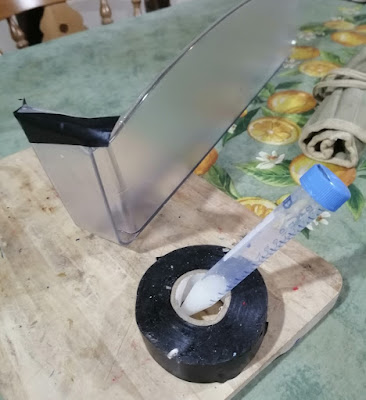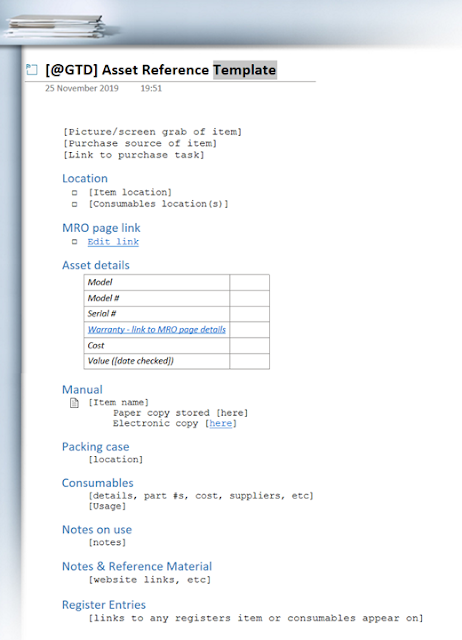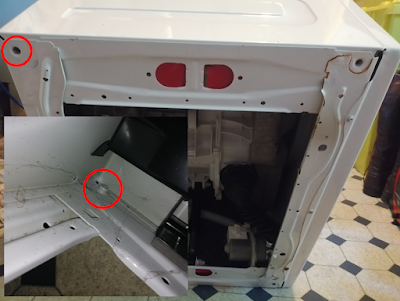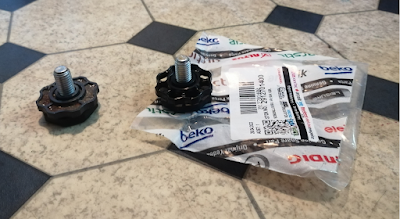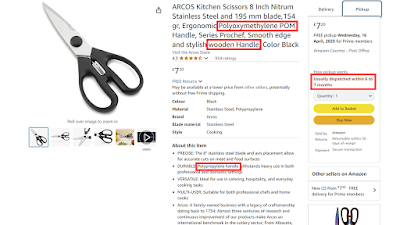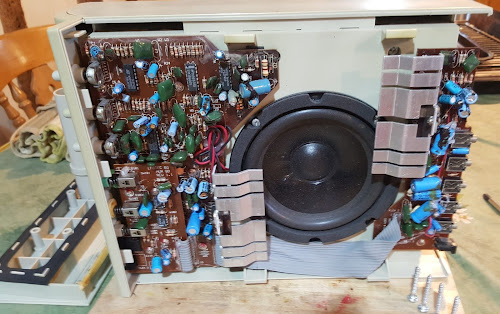Another day, another thing broken. The tin opener this time. The main problem being that it is not opening tins any more. It pierces the lids OK but just won't move round the tin as the gears keep slipping. On inspection this is because they are, technically speaking, shagged.
 |
| Old vs New Tin Opener |
I happened to have a new tin opener to hand and you can see that, apart from being almost identical bar the handle (?all made in the same factory), the gears on the old (and yes I know rusty) one are completely rounded over. So, just a matter of replacing the drive gears and it can be put back into service then?
 |
| Partially dismantled tin opener |
Well the tin opener can be reversibly dismantled with hand tools, which is a good start. There was a stainless steel screw holding the angled drive gear and blade assembly in position and the other flat drive gear was held onto a threaded spindle and could be released by holding the finer toothed gear above it with a pair of pliers and screwing off the handle.
 |
| Nadgered drive gear |
As you can see the cogs on the drive gears were irretrievably damaged. But their repair ought to be simply a matter of buying a replacement set on the web and fitting them, no?
No, not allowed. Why let you pay a quid for new parts that are standard across multiple brands when we can make you buy a whole new tin opener and, even better, we'll shave a few pennies more off of the manufacturing process making the new one even more difficult to repair.
 |
| New opener mechanism |
You can see that they have replaced the screw thread on the handle on this model for a permanent rivet and the screw and thread on the angled blade for a one-way press fitting. Just in case you might be able to work around the lack of parts.
This is a great (not really) example of manufacturing enshittification by prevention of repairs planned obsolescence. Watch Louis Rossman cover this by example of LED ceiling fans.
 |
| Louis Rossman |
Believe me I tried really hard to source these parts on-line and came up with a blank. Either they just aren't available or I am completely failing to use the correct search terms/pictures.
So in order to fix the tin opener I would have to actually make the parts. This has been successfully attempted by at least one person in a real tour-de-force display of engineering bloody-mindedness. But only for the flat drive gear and on an opener where the angled drive gear was in better shape. Also I don’t have a Sherline mill handy… Unfortunately I needed to replace the angled one as well, which comes as an assembly with the cutting blade. Both are notched (double D-holes) and what looks to be press-fitted together onto a spindle.
It was just not practical to make both pieces; the flat gear is difficult but not impossible; the gear-and-blade combination is, however, too much trouble for a £5-10 piece of kit. I will point out that this doesn't absolve the manufacturer for having no spares available and offering something that can't be fixed. Thus costing the earth yet another dollop of resources it doesn't need to part with; I am throwing out 170 g of tin opener because I can't replace 9 g of duff parts.
Resignedly I had to accept the fact that I would have to dance to the manufacturers' tune and buy a new, even less reparable tin opener.
After a long dive into review sites, reddit, etc. I came to the conclusion that they had all tested brand new openers and no-one had published _any_ data on how well they work over time or how long they last. Suffice to say the older your tin opener the more likely it is to be a bit blunt but still working. The lifespan of a new tin opener appears to be about a couple of years and generally people are dissatisfied with that fact (even product designers).
My decision tree was, manual not electric, then not something dirt cheap like a butterfly opener, but after that I was fairly agnostic about which brand to go with. In no particular order here are the results from an incomplete selection of review sites.
I also asked Copilot for a recommendation and the Oxo opener came up on its list (although I am not sure whether it is really 'reviewing' all the options rather than just providing one). Some amusing points were America's Test Kitchen getting roundly abused in their comments section for not being able to use a safety can opener and coming down against them and the Which? reviewer being obsessed with the size of the opener. Really, who cares what size a tin opener is? There's plenty of stuff that you could throw out of most utensil drawers before you got rid of the tin opener.
In the end I decided to weigh the reviews on Amazon, counting any reviews with three stars or less as dissatisfied customers. In last place was the Joseph & Joseph Can-Do opener with 27% not satisfied out of 4,500 ratings. Next came the Zyliss Lock 'n' Lift opener with 18% dissatisfied out of 27,450 ratings, then the EZ-duz-IT opener with 9% (but not being in the States it was too expensive anyway) on 13,900 ratings. Finally, the best rated was the Oxo Good Grips opener with only 8% dissatisfied on 50,100 ratings
 |
| Oxo Good Grips Soft-Handled Can Opener |
So Helen of Troy earned the sale and I bought an Oxo Good Grips Soft Handled Can Opener, which is essentially a like-for-like replacement for the defunct KitchenCraft opener. I am extremely dubious that A) it will last as long as the recently deceased one or B) that the Oxo brand name implies any better quality than any other opener. But they are offering a lifetime warranty on the opener so perhaps I will be proved wrong (their customer service dept. claims 10-15 years of use). It is also completely unrepairable.
 |
| Kuhn Rikon Safety Can Opener |
As I am a sucker for new tools I also bought a Kuhn Rikon Safety Can Opener, even though its' dissatisfaction rating was 16% on 14,100 ratings. Mostly because of the comments in the America's Test Kitchen video and a video by Technology Connections. It comes with a three year guarantee and just looks cool. And again, it is also completely unrepairable.
In conclusion then, most tin openers are now unrepairable by design, despite earlier models having this feature. Once the blade dulls or the gears wear out the whole thing has to go into the waste, which is a shame as 95% of the opener is still functional.
This got me thinking. There is free open-source software for almost every application out there. Where is the open-source hardware movement? Are we limited to electronics (Raspberry Pi, Arduino, etc.) and basic components (like resistors and screws)?
The answer appears to be, mostly yes. In the kitchen area there is a bit of stuff on actual kitchens but searching for open source kitchen utensils doesn't return much of anything, apart from a really nice blender. Further digging found a few prints on Thingiverse for replacement handles for tin openers. Including a nice one that improves standard butterfly openers making them easier to use.
 |
| Open Source Hardware Tin Opener |
The nearest I got was a student project by Alexander Cielsa which provides .stl files for most of a standard Bunker-type can opener. The author claims to have sourced the gears and cutting blade from "a local hardware store", which is a bit doubtful given my experience. A more likely source was from another, working opener than from the local hardware store. In fact you can see the rust on the gears in the photos of the finished opener.
But I am not knocking the effort, it is a really good start. In fact the only things missing are the gears and cutting wheel, which brings me back to the same dead end. Until I or, more likely, someone else out there works out how to source these components, tin openers are going to stay a disposable item, unhappily.
JOB DONE
Time taken: Too long
Cost: Oxo opener - £8.00; Kun Rikon opener £14.95
P.S. Yes I know it is overkill to buy two, but hey, at least when one breaks I'll have a spare.

